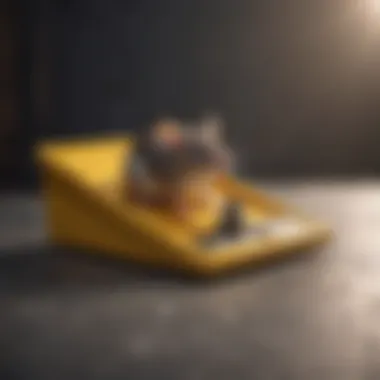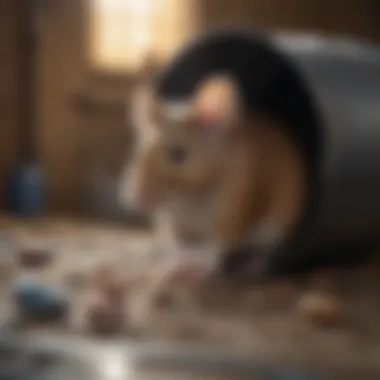A Comprehensive Guide to the Effective Bucket Method for Catching Mice


Preventive Pest Control Strategies
For any homeowner, preventing pests from invading their living space is paramount. Without adequate prevention, dealing with pest infestations can become a tedious and costly ordeal. To safeguard your home effectively, it is crucial to implement a combination of preventive pest control strategies that target various areas both inside and outside your home.
House Exterior Protection
When it comes to preventing pests from entering your home, paying attention to the exterior is key. Start by inspecting the outer walls and foundation for any cracks or openings that pests could use to gain entry. Sealing these cracks with appropriate sealants can significantly reduce the chances of pests finding their way indoors. Additionally, keeping your yard free of debris and organic matter can help eliminate hiding spots and breeding grounds for pests.
Yard Maintenance
A well-maintained yard not only enhances the aesthetic appeal of your home but also plays a crucial role in pest prevention. Regularly mowing the lawn, trimming bushes and trees, and removing standing water can deter pests from making your yard their playground. Implementing pest-repelling plants and natural deterrents can further enhance your yard's pest-free status.
Indoor Cleanliness
Maintaining a clean and clutter-free indoor environment is essential for effective pest control. Regularly vacuuming, sweeping, and dusting can help eliminate crumbs, spills, and other attractants that entice pests into your home. Proper food storage in airtight containers and promptly fixing leaky faucets can also deprive pests of food and water sources, making your home less appealing to them.
Garbage Disposal
Proper garbage disposal is a crucial aspect of pest control. Ensure that your trash bins are tightly sealed to prevent pests from accessing food waste. Regularly emptying the bins, cleaning them with disinfectants, and keeping them away from the house can significantly reduce the risk of pest infestations.
Other Pest Prevention Strategies
In addition to the aforementioned measures, there are various innovative ways to safeguard your home against pests. Installing mesh screens on windows and doors, using door sweeps to seal gaps, and incorporating ultrasonic pest repellents are some modern methods that can complement traditional pest control strategies.
Introduction
In the realm of pest control, the bucket method stands out as a humane and effective approach to dealing with unruly mice infestations. This article aims to delve into the intricacies of this method, offering housewives and homeowners a detailed guide on how to implement this strategy successfully. By exploring the nuances of the bucket method, individuals can elevate their pest control capabilities and maintain a safe, mouse-free environment within their homes.
Understanding the Bucket Method
The bucket method is not merely a modern invention but has a historical lineage that traces back through time. Understanding the history of this method provides insight into its evolution and effectiveness in managing mouse populations. By grasping the key principles behind the technique, individuals can grasp the underlying mechanisms that drive its success. The benefits of employing the bucket method extend beyond mere pest control, offering a sustainable and eco-friendly solution to a common household problem.


History of the bucket method
The evolution of the bucket method spans centuries, with its roots embedded in the ingenuity of past generations. This historical context illuminates the gradual refinement of this technique, showcasing its enduring relevance in contemporary pest control practices. The utilization of rudimentary traps in ancient civilizations laid the foundation for the sophisticated bucket mechanisms we see today. This historical lineage cements the bucket method as a time-tested strategy, revered for its simplicity and efficacy in tackling mouse infestations.
Key principles behind the technique
At the core of the bucket method lie fundamental principles that govern its functionality. These principles encapsulate the essence of this approach, emphasizing precision, efficiency, and ethical pest management. By adhering to these principles, individuals can optimize their traps and maximize their success in capturing mice. The reliability and practicality of these principles make the bucket method a preferred choice for those seeking a humane and non-toxic solution to their rodent woes.
Benefits of using the bucket method
Employing the bucket method confers a myriad of benefits to households grappling with mouse infestations. From its cost-effectiveness to its ecological sustainability, this method presents a holistic approach to pest control. By utilizing readily available materials and harnessing the power of simplicity, individuals can mitigate their reliance on harmful chemicals and traps. The bucket method not only offers a humane solution to pest issues but also promotes a safer environment for families and pets.
Setting Up the Trap:
Setting up the trap plays a pivotal role in the effectiveness of the bucket method for catching mice. It is a crucial step that determines the success of capturing mice without causing harm. Two main components need careful consideration: choosing the right bucket and selecting the bait. By paying attention to these elements, homeowners can significantly increase the trap's efficiency.
Choosing the Right Bucket:
When it comes to selecting a bucket for mouse trapping, various factors must be taken into account. The ideal size and material of the bucket are critical for ensuring the trap's functionality. A larger bucket is generally preferred as it provides ample space for capturing multiple mice at once. Opting for a sturdy material like metal or heavy-duty plastic is essential to prevent mice from escaping or damaging the trap. These characteristics make the bucket a reliable choice for effectively containing mice and facilitating their safe removal.
Enhancing Trap Effectiveness with Modifications:
In enhancing the trap's effectiveness, modifications can play a vital role. Adding a ramp to the bucket's lip can make it easier for mice to access the trap, increasing the likelihood of successful captures. Additionally, incorporating a mechanism to stabilize the bucket can prevent accidental tip-overs, ensuring the trap remains functional even after capturing mice. These modifications not only boost the trap's efficiency but also improve its overall usability.
Selecting Bait:
Choosing the right bait is crucial for luring mice into the trap. Opting for highly attractive bait options such as peanut butter, chocolate, or seeds can significantly increase the trap's effectiveness. Avoiding common baiting mistakes, such as using too much bait or placing it in the wrong location, is essential for ensuring that mice are enticed to enter the trap.
Avoiding Common Baiting Mistakes:
One common mistake to avoid is using excessively large quantities of bait, as this can make it easier for mice to steal the bait without triggering the trap. Another mistake is placing the bait too close to the edge of the bucket, which may allow mice to grab the bait without fully entering the trap. By steering clear of these errors, homeowners can maximize the trap's success rate.
Placement and Timing:


Strategic placement and optimal timing are key to successfully catching mice using the bucket method. Identifying ideal locations for setting up the trap, such as along walls or near potential entry points, can increase the chances of capturing mice. Additionally, activating the trap during periods when mice are most active, such as at night, can enhance its effectiveness.
Ideal Locations for Setting Up the Trap:
Placing the trap near areas frequented by mice, such as food storage or nesting spots, is crucial for attracting them to the trap. Moreover, positioning the trap along common mouse pathways can heighten the chances of capturing multiple mice in one setting. Choosing strategic locations for the trap increases its efficiency in addressing mouse infestations.
Optimal Timing for Trap Activation:
Timing plays a critical role in trap activation, as setting the trap during peak mouse activity periods can yield better results. Activating the trap during the night when mice are most active increases the likelihood of successful captures. Additionally, monitoring mouse behavior and adjusting the timing of trap activation accordingly can further improve its efficiency.
Executing the Trap
In this comprehensive guide on the Bucket Method for catching mice, the section on Executing the Trap holds significant importance. This phase marks the crucial transition from preparation to action. The meticulous execution of the trap ensures the effectiveness of the entire trapping process. It involves activating the trap, monitoring its functionality, and subsequent maintenance.
This stage demands precision and attention to detail to maximize the trap's efficiency. Proper execution of the trap minimizes the chances of escape for captured mice, allowing for a swift and humane resolution to the infestation. Additionally, executing the trap in a timely manner is essential for timely removal of unwanted pests.
Activating the Trap
Ensuring proper trap functionality
When discussing the aspect of ensuring proper trap functionality, we delve into the core of trap execution. The effectiveness of the trap hinges on its ability to function as intended. This entails checking for any defects, ensuring all components are in place, and verifying that the bait is enticing enough to lure mice into the trap.
One crucial feature of ensuring proper trap functionality is the stability of the setup. A secure and steady trap increases the chances of successful capture, preventing any premature triggers or escapes by the mice. This aspect is particularly favored in this article due to its emphasis on achieving optimal results with the Bucket Method.
Being mindful of safety considerations
Safety considerations play a pivotal role in trap execution, reflecting a conscientious approach to pest control. Prioritizing safety not only safeguards the homeowner from potential hazards but also ensures the humane treatment of captured mice. By implementing safety measures such as securing the trap in pet-free zones and using gloves when handling the trap, the risk of accidents or injuries is significantly reduced.
Emphasizing safety in trap execution aligns with the overall theme of responsible pest management promoted in the Bucket Method guide. While safety considerations may add an extra layer of precaution, they ultimately contribute to a smoother trapping process and promote a more ethical approach.
Monitoring and Maintenance


Monitoring and maintenance are integral components of trap execution, directly impacting the trap's longevity and efficiency. Regularly checking the trap allows homeowners to assess its performance, identify captured mice, and make necessary interventions. This proactive approach ensures that any issues with the trap are addressed promptly.
The key characteristic of checking the trap regularly lies in its ability to provide real-time feedback on the trapping process. By diligently inspecting the trap, homeowners can ascertain its functionality, gauge the success of the baiting strategy, and adjust tactics if needed. This hands-on approach enhances the chances of effectively capturing mice using the Bucket Method.
Replacing bait as needed is another crucial aspect of trap maintenance. Fresh bait is essential to keep the trap enticing for mice, especially in extended infestation scenarios. By regularly replenishing the bait, homeowners maintain the trap's allure, increasing the likelihood of capturing mice successfully. This strategy ensures continuity in trapping efforts and contributes to a proactive pest control approach.
The unique feature of replacing bait as needed lies in its adaptability to varying infestation levels. Whether dealing with a mild incursion or a persistent infestation, adjusting bait frequency to match the influx of mice optimizes trap performance. This personalized approach enhances the trap's efficacy and streamlines pest management efforts.
Disposal and Release
When it comes to dealing with a mouse infestation, proper disposal and release of captured mice is a crucial aspect of the process. Not only does it ensure that the mice are handled humanely, but it also helps prevent further infestations in the future. Humane disposal methods play a significant role in maintaining a balance between addressing the issue at hand and showing compassion towards wildlife. By following the right protocols for disposal and release, you can contribute to a more ethical and effective approach to pest control.
Humane Disposal Methods
Humane disposal methods are essential in upholding ethical standards when it comes to dealing with captured mice. Handling captured mice safely is a key component of this process. It involves ensuring that the mice are not harmed during the trapping and release process. This method emphasizes the well-being of the mice, even as you seek to remove them from your premises. Handling captured mice safely is not only a humane choice but also a practical one, as it reduces stress on the animals and maintains a more sustainable ecosystem.
Handling captured mice safely
Handling captured mice safely involves using proper trapping techniques that minimize harm to the mice. By being gentle and cautious in how you handle the mice, you can avoid causing unnecessary distress or injury to the animals. This approach is beneficial for both the mice and the environment, as it promotes a more harmonious coexistence between humans and wildlife. The unique feature of handling captured mice safely lies in its emphasis on respect for life, showcasing a compassionate approach to pest control within the context of this article.
Options for releasing mice back into the wild
When it comes to releasing captured mice, having options for their release back into the wild is essential. This allows the mice to return to their natural habitat, away from human dwellings, reducing the chances of them returning to your home. Offering mice the opportunity to go back to where they belong supports their well-being and ensures that they can continue their natural behaviors without interference. The careful release of mice into appropriate environments benefits both the animals and homeowners, creating a win-win situation in addressing mouse infestations.
Sanitizing and Resetting the Trap
After capturing and releasing the mice, sanitizing and resetting the trap is paramount to maintaining its effectiveness for future use. Cleaning the trap for reuse involves thorough cleaning and disinfection to remove any lingering odors or pathogens. This ensures that the trap remains hygienic and efficient for subsequent trapping efforts. The unique feature of cleaning the trap for reuse lies in its ability to prolong the trap's lifespan and maintain optimal functionality, a practical consideration for homeowners dealing with recurring pest issues.
Cleaning the trap for reuse
Cleaning the trap for reuse requires attention to detail and meticulous cleaning practices to ensure its efficacy. By thoroughly sanitizing the trap and removing any traces of bait or residue, you can reset it for future use without compromising its performance. This careful cleaning process not only enhances the trap's efficiency but also contributes to a more sustainable approach to pest management. Homeowners can benefit from the reliability and longevity of the trap through regular maintenance and cleaning, fostering a more effective pest control strategy.
Preventing future infestations
Preventing future infestations is a proactive step towards maintaining a pest-free environment. By implementing measures to deter mice from returning to your property, you can reduce the likelihood of recurring infestations. This approach involves identifying entry points, sealing off potential access areas, and maintaining a clean and clutter-free environment to discourage mice from inhabiting your space. The key characteristic of preventing future infestations is its focus on long-term solutions rather than temporary fixes, offering homeowners a sustainable and permanent way to address pest concerns.
Preventing future infestations
Preventing future infestations is a strategic approach to pest control that aims to address the root causes of infestations. By taking preemptive measures to secure your property against potential entry points for mice, you can minimize the risk of future invasions. This proactive strategy not only protects your home from pest-related damage but also promotes a safe and healthy living environment for you and your family. The advantages of preventing future infestations include long-lasting results and peace of mind, knowing that your home is safeguarded against unwanted intruders.



